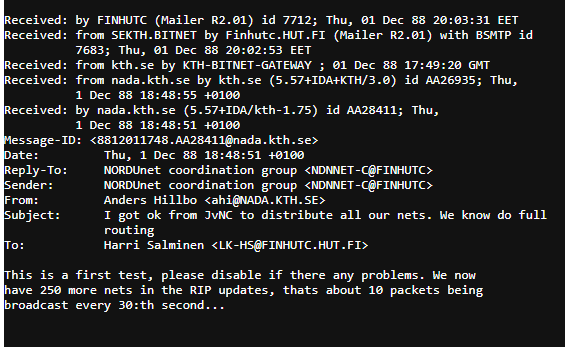Funet’s anniversary: 40 years of action and 35 years in Internet
This year marks the 40th anniversary of the Funet (Finnish University and Research Network) and the 35th anniversary of Finland’s connection to the global internet. Funet, which is celebrating its anniversary, can be proud of its many achievements, not least the connection of Finland to the internet. The future also looks bright; Funet and online services have become even more important in enabling Finnish science and the development of higher education.
Today, data networks are one of the most important infrastructures. They have become an everyday thing and a necessity for us, and the more devices and services we connect to the network, the more important they become. Today’s services are based on early innovations and experiments, which were the starting points for development.
For CSC services, the Funet network is the solid foundation on which the future can be built. Research data is transferred online for researchers’ use, and supercomputers are operated over the network. Services, data flows and resources for education would not work without the Funet network.
Important milestones
The internet has its roots in the late 1960s with the US defence department ARPANET (1969) and, a bit later, the first network connecting US universities. In Finland, the need for a network connecting universities was identified in the early 1980s. In 1983, the Ministry of Education set up the Funet project, in which a small group of IT experts with an interest in telecommunications was given the task of coordinating the development of a data network linking universities. Funet was founded on 29.12.1983 and in the following year the Funet network connected the universities’ mainframe computers.
Here we highlight some of the major milestones in Funet’s 40-year journey.
First message on the internet
On Thursday December 1st, 1988, the first routing test was carried out, allowing IP packets to pass from Finland via Nordunet to the USA, in effect the National Science Foundation’s NSFNET and Arpanet networks. This connected Finland to the international Internet via the Funet network. The following message can be seen as the beginning of the Finnish Internet.

The RIP in the message means routing information protocol.
Nic.funet.fi and the Linux world conquest
Linux is the most famous and probably the most important open source software development success story.
The Linux family of operating systems can now be found on everything from home appliances and Android phones to home computers, from servers running people’s common services to supercomputers grinding out heavy scientific computing. Even in data networks, servers and routers run on Linux.
Linux’s birthday is August 24, 1991, when Linus Torvalds, who coded the Linux kernel, wrote in the comp.os.minix newsgroup that he was doing a free operating system: “I’m doing a (free) operating system (just a hobby, won’t be big and professional like gnu).”
On September 17, 1991, Torvalds made Linux version 0.01 openly available to everyone via the CSC file server nic.funet.fi. File servers or ftp servers were a very important service in the early days of the Internet. Funet’s file server nic.funet.fi is still in use today and one of the longest running internet services in Finland.
Electronic identification
As the number of online services increased, the need for electronic identification of the individual emerged. The project for electronic identification in universities was launched in year 2000 with funding from the Ministry of Education and universities of applied sciences joined a little later. This led to the creation of the Haka trust network, which provides an authentication service that allows users to log in with their home organizations’ IDs to services provided by other organizations, such as the collaboration platform Eduuni or the Electronic Examination system.
At this time, electronic identification was being developed by many organizations and Funet was a major contributor. Early experiments with electronic identification have enabled online services to the extent that they exist today: from public authorities such as Kela, the Social Insurance Institution of Finland, or the Tax Administration to online banking services and a wide range of what we consider to be our everyday life.
Funet CERT and information security
The growth in the number of users and new services made the internet more vulnerable. Computer Emergency Response Teams (CERTs) were set up in different countries to respond quickly to various network security threats. Funet was a pioneer in information security, and in 1995 it set up Finland’s first CERT to share information about network security threats and guidelines for responding to them. Today, the increasing use of various cloud services has further emphasised the importance of security work, also in the Funet community.
Quantum technology
There are high expectations for quantum technology. A quantum computer needs supervision by traditional supercomputer and Finland’s first quantum computer was connected to the supercomputer LUMI – via Funet, of course.
The quantum computer is seen not only as a revolutionizer in computational science, but also as a very powerful crypto-breaker, so the preparations for the quantum age are also underway in the field of network technology. Funet is involved in building the first experimental network for quantum encryption.
High capacity data connections
In the early 2000’s, Funet introduced high-speed connections known as ‘light paths’, which are separate connections from the rest of the internet and designed for the specific needs of science and research. One of the first users was the Metsähovi radio observatory in Kirkkonummi, Finland. The 10 Gbit/s light path was used to transfer measurement data collected by the Metsähovi radio telescope for reprocessing at research centers in Central Europe and the US. Previously, data had been transferred by mailing hard disks.
Funet has also tested the network’s performance over ultra fast data connections and has set two world records for data transfer.
In 2021, bits could be transmitted at 800Gbit/s over a distance of more than 2 000 km, further than anyone else had been able to do over the network in regular use.
In 2022, Funet and Sweden’s Sunet were able to transmit data at 400 Gbit/s over a distance of 10 000 km. In 2023 and 2024, Funet will deploy the first 400 Gbit/s backbone connections, among the first National Research and Education Networks in the world.
In 2023, Funet provided the Eiscat3D research project with 3 x 4 Tbit/s connections to Kaaresuvanto in Finland, Skibotn in Norway and Kaiseniemi and Kiruna in Sweden, together with the Nordic networks Sikt in Norway and Sunet in Sweden. The EISCAT 3D radar system provides three-dimensional view of atmospheric phenomena, such as the aurora borealis.
